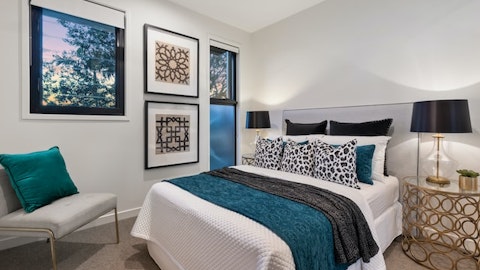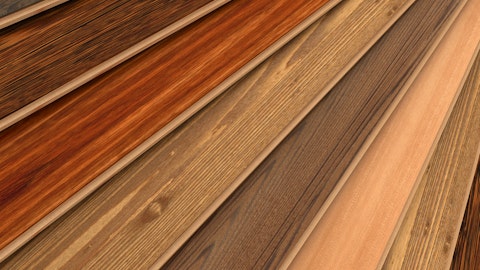Armstrong World Industries, Inc. (NYSE:AWI) Q3 2023 Earnings Call Transcript October 24, 2023
Armstrong World Industries, Inc. beats earnings expectations. Reported EPS is $1.6, expectations were $1.3.
Operator: Good morning. My name is Colby, and I will be your conference operator today. At this time, I would like to welcome everyone to the Q3 2023 Armstrong World Industries Earnings Conference Call. All lines have been placed on mute to prevent any background noise. After the speakers’ remarks, there will be a question-and-answer session. [Operator Instructions] Thank you. I’ll now turn the call over to Theresa Womble, Vice President of Investor Relations and Corporate Communications. You may begin.
Theresa Womble: Thank you, Colby, and welcome everyone to our call this morning. On today’s call, Vic Grizzle, our CEO; and Chris Calzaretta, our CFO will discuss Armstrong World Industries third quarter 2023 results and our rest of year outlook. To accompany these remarks, we have provided a presentation that is available on the Investors section of the Armstrong World Industries website. Our discussion of operating and financial performance will include non-GAAP financial measures within the meaning of SEC Reg G. A reconciliation of these measures with the most directly comparable GAAP measures is included in the earnings press release and in the appendix of the presentation issued this morning. Both are available on our website.

Copyright: archidea / 123RF Stock Photo
During the call, we will be making forward-looking statements and these statements represent the view we have of our financial and operational performance as of today’s date, October 24, 2023. These statements involve risks and uncertainties that may differ materially from those expected or implied. We provide a detailed discussion of the risks and uncertainties in our SEC filings, including the 10-Q filed earlier this morning. We take no obligation to update any forward-looking statement beyond what is required by applicable securities law. And now, I’ll turn the call to Vic.
Vic Grizzle: Thank you, Theresa, and good morning, everyone, and thank you all for joining our call this morning. As most of you have seen in our press release this morning, we delivered strong third quarter results. We generated strong sales and earnings growth while still facing weak market conditions that dampened overall demand in both our Mineral Fiber and Architectural Specialties segments. Our results were stronger in the quarter than we expected, largely due to the fact that we did not experience a further deterioration of market activity as initially expected, and due to the outstanding execution by our teams. Now, before we get into more of the details of these results, I’d like to recognize the strong execution by our teams in the quarter and, in fact, throughout the entire year.
I appreciate the efforts spent across the company to deliver the highest quality products with the best service levels in our industry, while also successfully implementing our growth initiatives. So, thanks to the entire Armstrong team. For the quarter, total company adjusted EBITDA increased 19% on a 7% increase in net sales. Total company adjusted EBITDA of $125 million marks the highest quarterly result in the history of our business with adjusted EBITDA margin expanding 380 basis points. Both our segments Mineral Fiber and Architectural Specialties reported record setting quarterly sales and earnings with robust margin expansion. These results are truly emblematic of the resilience of our business with a strong market position, a diverse set of end markets and effective growth initiatives, all providing strength and stability to our sales and earnings even when one or two of our verticals are under pressure.
Now, taking a closer look at our Mineral Fiber segment, we delivered 7% sales growth and 18% adjusted EBITDA growth. The strong sales results were largely due to better than expected sales volumes, as the anticipated weaker economic backdrop in the second half of 2023 has not materialized. The market we experienced was more similar to what we had seen in the first half of 2023. We also expected a more pronounced reversal in sales volumes in our home center or big box channel given the inventory build earlier in the year. While we did see lower third quarter sales volumes in this channel, it was not at the level expected. Our growth initiatives this quarter continued to gain momentum and contributed 2 points of Mineral Fiber volume growth in the quarter.
Much of this was driven by our initiatives designed to drive more renovation activity, with the highlight in the quarter being our digital initiative Canopy by Armstrong. Third quarter sales through the platform more than doubled from prior year levels, and for the first time since the platform launched Canopy was a positive contributor to EBITDA growth. This is an exciting milestone for this important growth initiative. As a reminder, what we’re driving for with the Canopy platform is a cost effective way to access the 60% of the installed base of Mineral Fiber ceilings that need renovating, but whose decision makers have limited access to knowhow and solutions to get it done. Canopy offers these customers an easy-to-use platform and creates awareness on our broad assortment of products and solutions.
What’s particularly encouraging thus far is how Canopy is attracting a new and different set of customers to Armstrong and that the base of repeat customers continues to grow. Project works our automated design service also continues to gain traction and is strengthening our project specifications with products at the high end of our portfolio contributing to our strong AUV performance. The number of projects through this platform continues to grow and our win rate on these projects continues to be meaningfully higher than our overall average win rate. Adding to both incremental volume and average unit value growth, now on that note, our AUV continues to be a highlight. AUV growth of 8% this quarter was driven by favorable pricing as well as positive mix.
We continue to innovate better ways to improve our service, customers, to earn our prices and the consistent mix contribution to AUV underscores our ongoing focus on delivering new product innovation, which fuels the product mix that we realize. All these factors, strong AUV growth, moderating inflation, strong contribution from growth initiatives, and improvement in earnings through our WAVE joint venture led to a Mineral Fiber adjusted EBITDA margin of nearly 42% a quarter, well on its way back to 2019 levels. Our Architectural Specialties segment also delivered a strong quarter with record setting sales and earnings. Adjusted EBITDA for the segment grew 30% versus the prior year third quarter, and adjusted EBITDA margin exceeded 20%. We delivered these results due to continued revenue growth along with better operating leverage.
I’m proud of the work this team is doing to get this business back to the 20% level, and in particular with our AS plants for their strong operational performance this quarter in terms of on time deliveries and low claims rates. We’re also pleased with the addition of BOK Modern to our Architectural Specialties segment, which is included in our results for the first time this quarter. This acquisition is adding more capabilities to Armstrong and is opening new opportunities for sales in new spaces. In terms of overall market activity in the Architectural Specialties segment, quoting activity continued to be positive, however less positive than we saw in the first half. We also experienced some choppiness in the order activity with some new orders being delayed.
Although, we’re seeing some increase in delays of project awards, we have not experienced project cancellations. We continue to see strength in transportation, particularly in airports and large municipal projects like convention centers. These are often larger projects and can be subject to delays given their complexity. So we are continually and carefully monitoring shifting schedules and overall project activity in this important segment. Before turning the call over to Chris for some more financial details, I wanted to take a moment to highlight an internal investment we’ve brought online in the quarter. It’s to expand our capacity and capabilities within our Architectural Specialties metal category. Metal has been a growth area for us over the last several years, and you’ve seen us active in acquisitions and unique metal – with unique metal design and production capabilities, including Arktura and Moz in 2020 and most recently BOK Modern.
One of our earlier acquisitions in metal was Steel Ceilings in Johnstown, Ohio, back in 2018 that primarily produces our metal works product line today. Because of our growth in metal overall and the centralized location of Johnstown, we’ve invested approximately $15 million over the last two years to expand the capability and capacity of this location. These investments include new equipment that allow us to broaden our capabilities and to be more efficient. With these investments, we will significantly advance our finishing capability and expect to be able to triple the production capacity of this site, while also significantly reducing lead times. The work we’ve done there, as well as through our acquisitions uniquely positions Armstrong to win larger projects and overall higher value business in the metal category.
And frankly, the timing could not be better with the infrastructure bill and the increase in transportation projects. I’ll come back in a moment for some more details, but Chris, over to you for the financials.
Chris Calzaretta: Thanks, Vic, and good morning to everyone on the call. As a reminder, throughout my remarks, I’ll be referring to the slides available on our website and Slide 3, which details our basis of presentation. On Slide 6, we discuss our quarterly Mineral Fiber segment results. Mineral Fiber sales growth of 7% was driven by strong AUV partially offset by lower volumes. AUV performance was driven by like-for-like pricing along with favorable mix. The positive mix benefit in the quarter was driven by channel mix. This strong AUV result marks another solid quarter of execution by our teams, and we remain on track to deliver AUV growth for the full year above our historical average of 5%. The decrease in Mineral Fiber volumes during the quarter was driven by overall softer market demand, the impact of one less shipping day, and lower sales volumes within our Latin America channel partially offset by the incremental contribution from our growth initiatives.
While third quarter Mineral Fiber volumes were lower than prior year, they were well ahead of our expectations. As Vic mentioned, the two drivers were a better than expected market and timing within our home center customer channel. Mineral Fiber segment adjusted EBITDA grew by $16 million or 18% to a record setting $105 million, and adjusted EBITDA margin expanded by 380 basis points. Driving this gain in margin expansion was AUV fall-through to EBITDA and lower input costs. While raw materials remain inflationary, tailwinds from energy and freight deflation provided a benefit as we lapped a prior year period that saw double-digit input cost inflation. Input costs this quarter also benefited from favorable inventory valuation impacts related to timing of input costs flowing through the P&L.
Recall that in the first quarter of 2023, we had a $6 million headwind from unfavorable inventory valuations. The positive impact in Q3 is part of a reversal of that headwind as input costs moderate. SG&A in the quarter increased $3 million versus the prior year, primarily due to an increase in selling expense and an increase in incentive compensation, where we lapped a benefit in the prior year quarter. As we outlook in our Q2 call, the year-over-year gain from WAVE equity earnings was more modest as compared to the first half of the year. The third quarter WAVE equity earnings gain was driven by lower steel costs and higher volumes, partially offset by lower AUV. On Slide 7, we discuss our Architectural Specialties or AS segment results, which are highlighted by record setting sales and adjusted EBITDA of nearly $100 million and $20 million, respectively.
Adjusted EBITDA margins expanded 370 basis points versus the prior year and above our minimum target of 20%. While we continue to see solid organic growth in the quarter, we were also pleased to see recent acquisitions, notably BOK Modern, which we acquired in July contribute to our overall incremental sales growth, another bright spot for AS was improved operating leverage. We continue to remain focused on leveraging SG&A as we grow the business, which is an important part of our path back to our minimum target of 20% EBITDA margins. And as always, we closely monitor project delays, which can cause choppiness quarter-to-quarter. Slide 8 shows our third quarter consolidated company metrics, where benefits from improved AUV, higher volumes, and lower input costs more than offset higher SG&A expense.
Consolidated adjusted EBITDA margin expanded 380 basis points with adjusted EBITDA up 19%. Adjusted diluted earnings per share increased 18% versus the prior year and adjusted free cash flow increased $26 million or 39% versus the prior year. Slide 9 highlights our year-to-date consolidated company metrics, where we grew adjusted EBITDA by 13% and expanded margins 220 basis points. These results are driven by the continued execution by our teams despite market headwinds. Adjusted diluted earnings per share increased 12% versus the prior year period and adjusted free cash flow increased $65 million or 50% versus the prior year. We’re well on our way to doing what we said we would do this year, which is to expand margins and grow adjusted free cash flow in a down market.
Slide 10 shows our year-to-date adjusted free cash flow performance versus the prior year. The increase was driven by working capital improvement, an increase in WAVE dividends, and higher cash earnings. This was partially offset by higher CapEx and higher cash interest. This year-to-date cash flow generation demonstrates our ability to consistently drive free cash flow growth despite challenging conditions and to deploy that cash to generate returns for the company through our capital allocation priorities. Our first capital allocation priority remains investing back into our business, where we see the highest returns. Next, we target strategic acquisitions that offer unique specifiable attributes and capabilities that leverage the strength of our businesses.
Third, we seek to return excess cash to shareholders. In the third quarter, we repurchased $40 million of shares and since the inception of our share repurchase program in 2016, we have repurchased a total of 13.7 million shares for about $948 million. After increasing our share repurchase authorization in July, we ended the third quarter with $752 million remaining under the existing authorization. And last week, we announced a 10% increase to our quarterly dividend, displaying continued confidence in our ability to generate cash over the long-term and further demonstrating our commitment to returning cash to shareholders. Slide 11 shows our updated full year guidance. We have improved our outlook for all key metrics based on a better than expected market.
We have narrowed the range for net sales and increased the midpoint slightly. We have also increase the midpoints for adjusted EBITDA, adjusted diluted EPS, and adjusted free cash flow. Given our year-to-date performance and outlook for the fourth quarter, we now expect improved full year profitability for the company. The changes in our assumptions are in the appendix of this presentation. And now I’ll turn it back to Vic for further comments before we take your questions.
Vic Grizzle: Thanks, Chris. Before we get to your questions, I’d like to take a moment and provide some additional context on the overall market backdrop, impacting both of our segments. As I mentioned earlier, in the back half of the year, we expected a lower level of economic activity to drive further deterioration of underlying market demand, namely on the renovation side. Instead, market demand appears to have stabilized at this lower level in the back half of the year. We continue to believe that the market weakness is mainly impacting discretionary spending on renovation and replacement activity, and primarily in the office vertical. Overall demand remains pressured by interest rate uncertainty, low office leasing activity, which creates the churn leading to renovation events and broader overall economic uncertainty.
But as we’ve reported, our business serves a wide range of vertical markets and project types. Education, with government funding support and healthcare were both positive in the quarter. These are helping to offset continued office weakness. In addition, as we outlook earlier this year, new construction starts from late 2021 and throughout 2022 contributed positively in the quarter. In consideration of more recent data, the data overall remains mixed. Dodge starts and bidding activity across many of the verticals has moved in and out of positive territory. Good funding conditions remain for education, healthcare and transportation. And in office, although, financial headwinds persist, the demand side of office appears to be stabilizing with growth in office employment continuing, more back to office mandates and less subleasing activity.
So even though our view on the market has modestly improved for 2023, there does remain a healthy level of uncertainty and concerns on the macroeconomic level. With that said, our strong results against these weaker market conditions are demonstrating the strength and the resilience of our business model and the strategy being deployed. And as outlined by Chris, our business is generating strong cash flow that allows us to fund all our capital allocation priorities, again, in all parts of the cycle. The strength and the resilience of our business is driven by the unique core attributes of our business. And these include the strength of our market position and a uniquely attractive building product category where scale, service and innovation matter, supported by an industry leading position with the A&D community that positions us well to innovate and to win more specifications than the others.
The attributes of the strength of our business in terms of the best-in-class distribution and we have the best-in-class distribution partners who are as passionate about the ceilings category as we are and lead the industry with their ability to consistently serve job sites. The stabilizing factor of having a balanced diverse set of end markets that rarely all move up or down at the same time. And because of these strengths, the unique ability we have to deliver consistent AUV growth and manufacturing productivity, again, even in down cycles. It’s these attributes and building blocks of our business that differentiate us in our industry and give us the confidence that we can grow revenue and expand profit margins in all parts of the cycle.
So as we go forward, we will remain focused and committed to these core value drivers and to delivering profitable growth next year and beyond. With those comments, we’ll be happy to take your questions.
See also 20 Countries with Lowest Rates of Cancer and 20 Countries that Produce the Most Motor Vehicles in 2023.
Q&A Session
Follow Armstrong World Industries Inc (NYSE:AWI)
Follow Armstrong World Industries Inc (NYSE:AWI)
Operator: [Operator Instructions] Your first question comes from the line of Susan Maklari from Goldman Sachs. Your line is open.
Susan Maklari: Thank you. Good morning, everyone, and congrats on a great quarter.
Vic Grizzle: Thank you, Susan.
Chris Calzaretta: Thanks, Susan.
Susan Maklari: Yes. My first question is, talking a bit about demand. Vic, in your comments you mentioned some delays that you’re seeing in some of the projects out there, also the discretionary side, especially in office, that continues to stay weak. I guess, when you think about what is driving that. What do you think needs to change in order to see us turn the corners there and what are some of the things you’re watching for?
Vic Grizzle: Yes. I think overall, I think the level of uncertainty remains in the marketplace. Even though, the uncertainty was driving a lot of the back half expectations for softer economic conditions that didn’t materialize. I still think given the geopolitical issues and I think interest rates, there’s still some uncertainty around their overall impact on the economy. And I think that gives especially in the discretionary area of renovation work, I still think there’s some pause there and I think that has to clear up before we can kind of get back to business with this discretionary renovation activity. On your first comment, with regards to some of the delays, speaking really to the Architectural Specialties side of the business, as we’ve talked about many times on this call, the Architectural Specialties business being so project intensive can have some ebbs and flows quarter-to-quarter.
And as we get larger and larger projects in our backlogs, namely these airport projects, for example, a little bit of delay in some of those projects can really influence the quarter-to-quarter ebbs and flows. And that’s, I think, what we’re seeing and I was highlighting in terms of the overall activity and some of the project delays, some of those can move our numbers quarter-to-quarter. But overall, we’re so well positioned in that space. We’re really excited about the Transportation segment overall.
Susan Maklari: Okay, that’s helpful color. And as a follow-up, you saw a very nice lift in the Architectural Specialties margin this quarter. Clearly, kind of getting on a quarterly basis closer to that longer term guide that you’ve given us, how do you think about the sustainability of the improvement that you’ve seen? And any thoughts on the path forward from here?
Vic Grizzle: Yes. Susan, we’re pleased, but we’re not surprised, right? The team has been working very hard on the right levers to pull to improve, namely the operating leverage. And it’s inside the plants. It’s the area outside of the plants, but as I called out in my prepared remarks, I’m really pleased with what our plants are doing to drive efficiencies and productivity. The operating leverage that we’re getting on the SG&A side is also notable. I think they’re pulling all the right levers, they’re executing, again, we’re very pleased with that case [ph]. We’re not surprised with their execution. And I think this is sustainable. As we go forward, we’re going to continue to work those levers around good productivity in the plants, getting the operating leverage on our investments that we’ve been making over the last year or so in this business. We believe we’re well on our way back to that 20% minimum target.
Susan Maklari: Okay. All right. Thanks for all the color and good luck.
Vic Grizzle: You bet. Thank you.
Operator: Your next question comes from the line of Garik Shmois from Loop Capital Markets. Your line is open.
Garik Shmois: Hi thanks and congrats on the nice quarter. Wanted to ask first, with respect to the volumes in Mineral Fiber, and I think you saw benefits at home center. Just curious as to what drove that. I think you were expecting some destocking. It doesn’t seem like that occurred. But maybe if you could talk to sell-in versus sell-through and some of the underlying trends that you’re hearing about there?
Vic Grizzle: Yes. On the home center, very specifically, the – which is our big box channel that we often talk about how that ebbs and flows quarter-to-quarter, right, with their drawdown on inventory and the buildup of inventory. And there was a pretty noticeable inventory build around some new products that we were gearing the stores up for resetting of inventory around some of these new products that, again, we were very open about that in the first half and there was some strong inventory build behind that. And when you look at the point-of-sale data, and they share their point-of-sale data with us, you can see that the point-of-sale data was mimicking pretty much what we were seeing in the overall market. And so this is a pretty good buy ahead of demand, and we expected that to be coming out, and they expected more of that to be coming out in the back half as they got up and running in their stores.
So it didn’t come out as fast. I don’t think any of us expected the market conditions that we saw in the third quarter, and we’re seeing in the back half that might have slowed down some of their intentional drawdown. That’s really for them, I think, probably to answer better than me. But overall, we did not see the drawdown in inventory at the same level we expected. What we are out looking is that they still intend to do that, and we expect that – more of that to come out in the fourth quarter. And you’ll see that in sort of our fourth quarter expectations. So did I get to your question there? Does that answer your question?
Garik Shmois: Yes, you did. No, that’s helpful. Thank you. And then I just wanted to ask on – I think you called out, if I heard it correctly, about two points of volume growth due to some of your growth initiatives that you said Canopy in particular. Curious as to maybe how sustainable this type of growth, maybe not pinning you to do 100 basis points per quarter, but should we expect some noticeable volume growth from some of these initiatives on a go-forward basis?
Vic Grizzle: Well, I think we outlooked – we reported 2% contribution to our volume growth in the quarter. We have been talking about a 1% to 2% contribution. So I believe we’re right in that range of what we expect on an ongoing basis in terms of contribution from these initiatives. I’d like to mention that healthy space has also contributed. We had a terrific quarter on the Canopy platform. That team is doing a terrific job turning it profitable. But also in our healthy space initiative, we continue to have positive contribution from our Healthy Spaces initiative. And our overall activity to help stimulate more renovation events in this large installed base that largely needs renovated. We’re trying to make – give them the catalysts and the reasons to do it in an easy way to get it done. So, I think we’re going to continue to see one point to two points of contribution from these growth initiatives going forward.
Garik Shmois: Got it. Thanks again.
Vic Grizzle: Yes. Thank you.
Operator: Your next question comes from the line of Keith Hughes from Truist. Your line is open.




